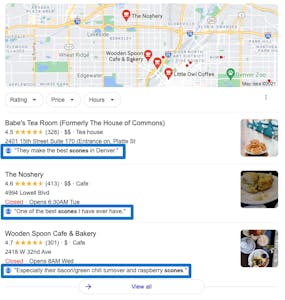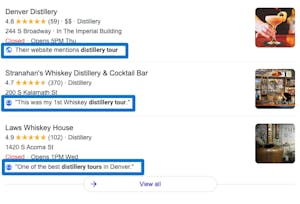- 12 minute read
- Business Management Tips
- Local Strategies
- SEO
Beginner,
Intermediate
Get a behind-the-scenes-look into FareHarbor's 2024 season

The main goal of the Google search engine results page (SERP) is to offer searchers the answer to their question as quickly and easily as possible. To this end, the SERP is full of features, big and small, that show users how each result matches their query.
Among these features are local justifications: small snippets of website or review content displayed in the local map pack, local finders, and Google Maps. These snippets highlight information relevant to the user’s search intent — the specific purpose behind their query.
For example, in this search for “where to get scones in denver,” the local map pack displays three bakeries in Denver, and the local justifications highlight reviews where scones are mentioned.

This is the type of detail you might not include in SEO elements like the title tag or headings, but Google finds the information elsewhere to enhance the search result and demonstrate its relevance.
Local justifications span just one or two lines of small text, but they can have a big impact as they help users narrow down their choice from the local map pack. They can influence click-throughs by showing searchers that you offer exactly what they’re looking for.
You might be wondering how common the local justifications feature is. Moz conducted a study to answer this very question, tracking 10,000 keywords daily. Here’s what they found:
Appearing on over half of local map pack results, local justifications are a great opportunity to gain more clicks. But how exactly can you use this feature to your advantage? Let’s take a look at where justifications come from and how to influence them.
Google pulls information from a variety of sources across their platform and your website, including:
While some justifications are easy to track to their source, others are based on data Google has about your business from unconfirmed sources. For example, the source of the “sold here” justification for stores is uncertain, but could include the business website, reviews, and more.
There’s no information out there on how the Google algorithm selects when to display local justifications or what type of justification to use. So there’s no verified method of influencing local justifications. However, you can set yourself up for success by making sure the information is available on your website, reviews, GMB profile, and beyond.
Here are a few tactics you can try to boost your local justifications:
We know a lot about certain Google features like GMB and featured snippets, but the inner workings of local justifications are less clear. However, all the elements local justifications pull from are important to your SEO strategy in their own right. You can’t help but benefit from ensuring that your reviews, website content, and GMB profile are as optimized for search as possible. Getting a local justification is a bonus for an SEO job well done!
Learn more about Google’s features in our SEO guides.